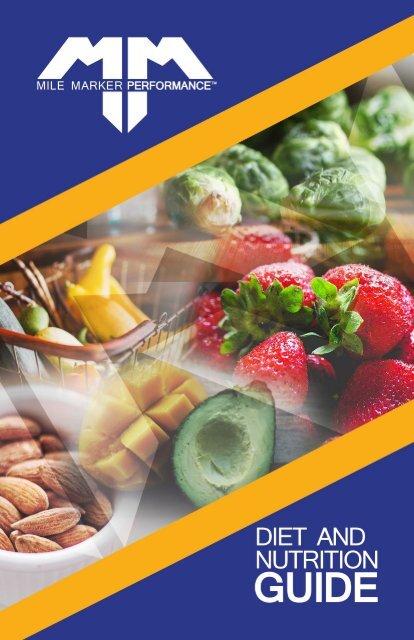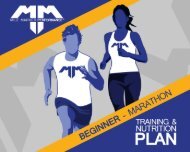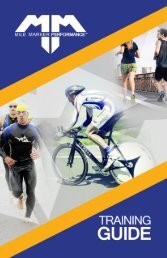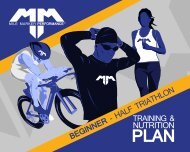Diet and Nutrition Guide Preview
You also want an ePaper? Increase the reach of your titles
YUMPU automatically turns print PDFs into web optimized ePapers that Google loves.
WELCOME TO YOUR DIET GUIDE!<br />
Greetings athletes,<br />
challenge seekers, <strong>and</strong><br />
fitness enthusiasts!<br />
Greetings swimmers,<br />
bikers, <strong>and</strong> runners! For<br />
some of you, this is<br />
the beginning of what<br />
is hopefully your long<br />
<strong>and</strong> fulfilling athletic<br />
story. For others, this<br />
may simply be the next<br />
chapter of: You, the Athlete. In either case, Mile<br />
Marker Performance is very excited to help you<br />
write it.<br />
What you will find in the following guide is<br />
meant to serve as both a diet <strong>and</strong> nutritional<br />
educational tool <strong>and</strong> a helpful supplement to<br />
your comprehensive training <strong>and</strong> nutrition plan.<br />
Whether you are interested in learning more<br />
about the importance of solid training <strong>and</strong> race<br />
nutrition, or just looking for fun, simple, <strong>and</strong><br />
healthy recipes, this guide has it all.<br />
Mile Marker Performance cares about helping<br />
you reach your racing goals, <strong>and</strong> we underst<strong>and</strong><br />
that means more than just logging the miles<br />
<strong>and</strong> the laps. Training for an endurance event<br />
is a holistic endeavor <strong>and</strong> in order to avoid the<br />
dreaded “bonk” you will need to put the right<br />
fuel in your tank. This guide will help you as you<br />
embark on your journey by explaining not only<br />
what fuel you need, but also why you need it.<br />
So with that… happy eating, happy training, <strong>and</strong><br />
happy racing! See you at the finish line!<br />
TABLE OF CONTENTS<br />
Section 1: <strong>Nutrition</strong><br />
Basics<br />
Pg. 2<br />
Section 2: Eating for<br />
Performance<br />
Pg. 33<br />
Section 3: Meal Planning<br />
Pg. 47<br />
Sample Meal Plan<br />
Pg. 51<br />
Recipes<br />
Pg. 53<br />
References<br />
Pg. 66<br />
MILE MARKER PERFORMANCE TM<br />
EVERYTHING<br />
YOU NEED TO RACE<br />
YOUR BEST -<br />
DELIVERED.<br />
Greg Raelson<br />
Founder, Mile Marker Performance<br />
DISCLAIMER:<br />
None of the statements in this product or in materials provided by Mile Marker Performance, LLC have been evaluated by the Food <strong>and</strong><br />
Drug Administration (FDA), nor should they be construed as dispensing medical advice or making claims regarding the cure or prevention<br />
of diseases, nor can the products mentioned or provided prevent heat stroke, hyponatremia, or any other injurious results of excessive<br />
physical exhaustion. Consult your physician or licensed health care professional before starting any supplement, dietary, or exercise<br />
program, especially if you are pregnant or have any pre-existing injuries or medical conditions. DO NOT assume that just because you<br />
have used similar supplements in the past, they will have the same effect.<br />
1<br />
Copyright 2016, Mile Marker Performance, LLC. This information is copyright protected.<br />
All information contained herein is copyright by Mile Marker Performance, LLC, <strong>and</strong> may not be duplicated, copied, modified or adapted,<br />
in any way without written permission. Doing so without authorization infringes the copyright <strong>and</strong> may lead to liability to Mile Marker<br />
Performance, LLC for damages.
SECTION 1: NUTRITION BASICS<br />
THE STUDY OF NUTRITION<br />
In its simplest form, nutrition is the science of food. It is<br />
the study of how the food we eat is digested <strong>and</strong> absorbed, as<br />
well as how the nutrients from the foods we eat <strong>and</strong> drink are<br />
utilized by the body. Nutrients are those specific substances in<br />
food that provide some kind of vital body function. While the<br />
body can make some nutrients, essential nutrients are those<br />
that must be obtained from the foods we eat; we cannot make<br />
them ourselves.<br />
The six main categories of nutrients are carbohydrates,<br />
fats, protein, vitamins, minerals, <strong>and</strong> water. We can further<br />
classify nutrients as either macronutrients or micronutrients.<br />
Macronutrients are needed in large quantities <strong>and</strong> include<br />
carbohydrates, fats, <strong>and</strong> proteins, <strong>and</strong> water. With the<br />
exception of water, macronutrients are often termed the energyyielding<br />
nutrients, meaning they provide energy in the form of<br />
calories. Micronutrients are needed in much smaller quantities<br />
<strong>and</strong> although they do not directly yield energy, they often<br />
assist with energy production. Vitamins <strong>and</strong> minerals are<br />
considered micronutrients.<br />
2
As a means to quantify the nutritional value of food, we<br />
often reference nutrient density. Nutrient density is essentially<br />
a ratio of the nutrients in a given food relative to how many<br />
calories that food provides. Foods <strong>and</strong> beverages with high<br />
nutrient density are generally considered healthier because<br />
of this high proportion of nutrients. These foods are also<br />
commonly referred to as quality calories.<br />
The study of nutrition is most often centered on the<br />
relationship between the foods we eat <strong>and</strong> their connection to<br />
health. Nutrients play so many important roles in the body<br />
from providing energy <strong>and</strong> supporting growth to enhancing<br />
immune function <strong>and</strong> helping prevent chronic disease. When<br />
we don’t consume enough of the nutrients we need, we<br />
compromise the body’s ability to function at its best, leading<br />
to poor health. Proper nutrition contributes to many positive<br />
health outcomes such as:<br />
- Maintaining a healthy weight<br />
- Reducing risk of cardiovascular disease, diabetes, cancer,<br />
<strong>and</strong> many other chronic diseases<br />
- Enhanced immune function<br />
- Improved bone mass<br />
- Better digestion<br />
- Reduced risk of nutrient deficiency diseases (such as<br />
anemia)<br />
- Living a longer <strong>and</strong> healthier life<br />
While we can’t control every aspect of our health,<br />
nutrition is one factor we definitely have control over to live a<br />
life of optimal health <strong>and</strong> quality.<br />
NUTRITION FOR THE ACTIVE INDIVIDUAL<br />
Most of us recognize that proper nutrition is vital to our<br />
health, but it’s an especially important consideration for those<br />
looking to improve their athletic performance, regardless of<br />
skill or fitness level. There is the misconception that active<br />
individuals <strong>and</strong> athletes don’t need to worry about their food<br />
choices; they can eat whatever they want <strong>and</strong> still expect to<br />
perform optimally. The study <strong>and</strong> science of sports nutrition is<br />
clearly dispelling this myth.<br />
3
4
More <strong>and</strong> more research is demonstrating that what,<br />
when, <strong>and</strong> how an athlete eats <strong>and</strong> drinks has<br />
a profound effect on his/her athletic performance.<br />
More <strong>and</strong> more athletes, regardless of ability, are<br />
recognizing that a solid nutrition plan can have a<br />
profound impact on performance.<br />
It is also true that exercise won’t negate<br />
poor food choices. Both proper nutrition <strong>and</strong><br />
regular exercise are essential to good health <strong>and</strong><br />
improvements in athletic performance. While many<br />
athletes generally have more leeway in their food<br />
choices because of their higher energy expenditure,<br />
nutrition is still of utmost importance. You truly<br />
cannot out-exercise a bad diet.<br />
Athletes <strong>and</strong> active individuals have unique nutritional needs<br />
based on the sport or activity they engage in. <strong>Nutrition</strong>al needs are<br />
highly individualized; however, there are many health <strong>and</strong> performance<br />
benefits that can be obtained by incorporating a solid foundation of<br />
proper nutrition into any training plan. A few key benefits of ensuring<br />
the appropriate selection <strong>and</strong> timing of foods <strong>and</strong> fluids include:<br />
- Adequate energy for exercise, whether it’s for training or competition<br />
- Optimal recovery from exercise<br />
- Positive adaptations during training<br />
- Improved immunity<br />
- Weight management, including weight loss <strong>and</strong> weight gain<br />
For example, an athlete training for a half-marathon may find<br />
that with improved eating habits, he is able to lose ten pounds <strong>and</strong><br />
shave ten minutes off his half-marathon time on race day. Another<br />
athlete may find that being more attentive to her carbohydrate intake<br />
during a full-distance triathlon delays the onset of fatigue, allowing her to<br />
keep a consistent energy level throughout the race. Many athletes find<br />
that by incorporating nutrition into their training, they have more energy<br />
for their workouts <strong>and</strong> recover faster. This allows them to get the most<br />
out of their training sessions, fostering the achievement of their fitness<br />
<strong>and</strong> athletic goals.<br />
HEALTHY EATING BASICS<br />
5<br />
Healthy eating is not a “diet” or choosing low-calorie foods. It’s<br />
also more than just eating a lot of vegetables <strong>and</strong> limiting processed<br />
foods. Healthy eating centers on obtaining all of the nutrients from<br />
food that our body needs to function properly. It’s a lifestyle habit that<br />
incorporates the principles of variety, proportion, <strong>and</strong> balance.
Variety<br />
In order to obtain all the nutrients our body needs,<br />
we need to consume a variety of foods. Not a<br />
single food exists that provides us with all of the<br />
nutrients we need. Every food <strong>and</strong> food group<br />
has a unique nutritional profile. For example,<br />
many fruits <strong>and</strong> vegetables are rich in vitamin C,<br />
potassium, <strong>and</strong> fiber, while meats <strong>and</strong> proteinrich<br />
foods are high in vitamin B12, iron, <strong>and</strong><br />
zinc. Diversity in our food choices better ensures<br />
we obtain a wide range of both macro- <strong>and</strong><br />
micronutrients in our diets.<br />
Proportion<br />
Beyond consuming a variety of foods, we also want to<br />
consume those foods in the right proportion. This refers to not<br />
only ensuring we meet our calorie needs, but also being mindful of<br />
consuming an appropriate number of servings from each food group<br />
based on our energy requirements. It’s often recommended that when<br />
we eat a meal, at least half of our plate should consist of vegetables<br />
<strong>and</strong>/or fruit. Another quarter of our plate should be a protein source,<br />
<strong>and</strong> the other quarter a complex carbohydrate. Because this ideal plate<br />
can often be a challenge to achieve at every meal, a good rule of<br />
thumb is to choose at least three foods from a different food group at<br />
each meal, one of which should be a fruit <strong>and</strong>/or vegetable.<br />
Proportion also refers to consuming an appropriate portion size<br />
of food. While each person’s nutrition needs are different, consuming<br />
the right proportion of foods in the right quantities will better ensure our<br />
nutrient needs are met. The website http://www.choosemyplate.gov/<br />
MyPlate-Daily-Checklist provides an estimated number of servings of<br />
each food group to consume each day based on an individual’s calorie<br />
needs.<br />
Balance<br />
Balancing food intake with physical activity is key to achieving<br />
<strong>and</strong> maintaining a healthy weight. However, the concept of balance<br />
also refers to our overall eating pattern. No one eats perfect all the<br />
time, nor are they expected to. While the majority of our calories should<br />
come from nutrient-dense foods, each person has a little wiggle room<br />
for his/her favorite treats. Following the 80/20 rule can be an effective<br />
strategy to ensure nutrient needs are met: At least 80% of the time,<br />
choose nutrient-dense foods from all of the food groups; the other 20%,<br />
eat <strong>and</strong> drink what you want. 6
The Food Groups<br />
As mentioned previously, consuming a variety of foods<br />
from each food group is essential to obtaining all of the<br />
nutrients our bodies need to function optimally. Foods from<br />
each of the food groups offer not only energy in the form of<br />
carbohydrates, protein, <strong>and</strong> fats, but they also contain various<br />
vitamins <strong>and</strong> minerals, <strong>and</strong> even water.<br />
Plant foods are unique in that in addition to the traditional<br />
nutrients they contain, they also provide phytochemicals.<br />
Phytochemicals are produced by plants for protection,<br />
but offer health benefits to us when we consume them.<br />
Fruits, vegetables, <strong>and</strong> whole grains are incredibly rich in<br />
phytochemicals.<br />
The chart below lists each of the food groups with<br />
examples, <strong>and</strong> highlights a few key nutrients found in each.<br />
Many foods can fit into more than one food group. Beans, for<br />
instance, PAGES are a 7-65 vegetable, NOT but INCLUDED can also be considered IN PREVIEW a protein<br />
source. Similarly, nuts <strong>and</strong> seeds can be categorized as either<br />
a protein or fat.<br />
FOOD GROUP NUTRIENTS EXAMPLES<br />
Fruits<br />
Vegetables<br />
Whole Grains<br />
Protein <strong>and</strong> meats<br />
Dairy <strong>and</strong> dairy alternatives<br />
Fats <strong>and</strong> oils<br />
Carbohydrates<br />
Vitamins such as A & C<br />
Folate<br />
Potassium<br />
Carbohydrates<br />
Magnasium<br />
Vitamins A, C, & K<br />
Fiber<br />
Magnesium<br />
Carbohydrates<br />
Fiber<br />
B vitamins<br />
Iron & magnesium<br />
Protein<br />
Fat<br />
Iron & zinc<br />
Vitamins B6 & B12<br />
Carbohydrates<br />
Protein<br />
Calcium & vitamin D<br />
Phosphorus<br />
Fat<br />
B vitamins<br />
Vitamin D & E<br />
Essential fatty acids<br />
Bananas<br />
Oranges<br />
Apples<br />
Berries<br />
Spinach<br />
Peppers<br />
Broccoli<br />
Squash<br />
Carrots<br />
Whole wheat<br />
Oats<br />
Quinoa<br />
Brown rice<br />
Meats & poultry<br />
Seafood<br />
Beans & peas<br />
Nuts & seeds<br />
Milk<br />
Non-dairy milk<br />
Yogurt & kefir<br />
Cheese<br />
Cooking oils<br />
Nuts & seeds<br />
Fish<br />
Avocados<br />
7
REFERENCES<br />
Academy of <strong>Nutrition</strong> <strong>and</strong> <strong>Diet</strong>etics, American College of Sports<br />
Medicine, <strong>and</strong> <strong>Diet</strong>itians of Canada. Position of the Academy of<br />
<strong>Nutrition</strong> <strong>and</strong> <strong>Diet</strong>etics, <strong>Diet</strong>itians of Canada, <strong>and</strong> the American<br />
College of Sports Medicine: <strong>Nutrition</strong> <strong>and</strong> Athletic Performance.<br />
JAND. 2016;116(3):501-528.<br />
National Academy of Sciences, Institute of Medicine, <strong>and</strong> Food <strong>and</strong><br />
<strong>Nutrition</strong> Board. <strong>Diet</strong>ary Reference Intakes: RDA <strong>and</strong> AI for Vitamins<br />
<strong>and</strong> Elements. May 2016. https://fnic.nal.usda.gov/sites/fnic.nal.usda.<br />
gov/files/uploads/RDA_AI_vitamins_elements.pdf<br />
Global RPh. Determination of the Resting Metabolic Rate (RMR).<br />
2016. http://www.globalrph.com/resting_metabolic_rate.htm<br />
Muth ND. Sports <strong>Nutrition</strong> for Health Professionals. Philadelphia, PA:<br />
F.A. Davis Company; 2015.<br />
Rosenbloom CA <strong>and</strong> Coleman EJ. Sports <strong>Nutrition</strong>: A Practice<br />
Manual for Professionals. 5th edition. Chicago, IL: Academy of<br />
<strong>Nutrition</strong> <strong>and</strong> <strong>Diet</strong>etics; 2012.<br />
Smith AM <strong>and</strong> Collene AL. Wardlaw’s Contemporary <strong>Nutrition</strong>. 10th<br />
edition. New York, NY: McGraw Hill Education; 2016.<br />
USA Track & Field. Preparation for Competing in Heat <strong>and</strong> Humidity.<br />
2016. http://www.usatf.org/Events---Calendar/2013/Pan-Am-Junior-<br />
Championships/Athlete-Info/Preparation-for-Competing-in-Heat-<strong>and</strong>-<br />
Humidity.aspx<br />
US Department of Agriculture. Food <strong>and</strong> <strong>Nutrition</strong> Information<br />
Center. Interactive DRI for Healthcare Professionals. May 2016.<br />
https://fnic.nal.usda.gov/fnic/interactiveDRI<br />
US Department of Agriculture. MyPlate Daily Checklist. May 2016.<br />
http://www.choosemyplate.gov/MyPlate-Daily-Checklist<br />
US Department of Health <strong>and</strong> Human Services <strong>and</strong> US Department<br />
of Agriculture. 2015-2020 <strong>Diet</strong>ary <strong>Guide</strong>lines for Americans. 8th<br />
edition. December 2015. http://health.gov/dietaryguidelines/2015<br />
Williams MH, Rawson ES, <strong>and</strong> Branch JD. <strong>Nutrition</strong> for Health,<br />
Fitness & Sport. 11th edition. New York, NY: McGraw Hill Education;<br />
2017.<br />
66
MILE MARKER PERFORMANCE TM<br />
EVERYTHING<br />
YOU NEED TO RACE<br />
YOUR BEST -<br />
DELIVERED.





